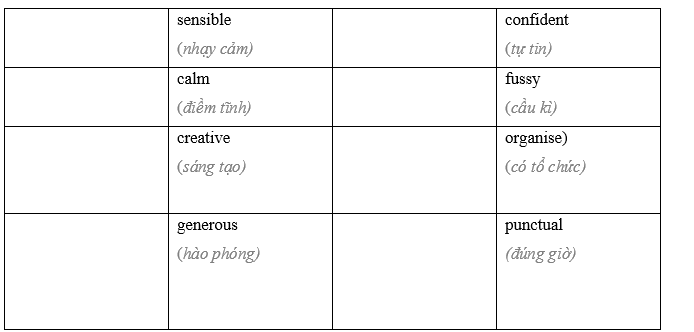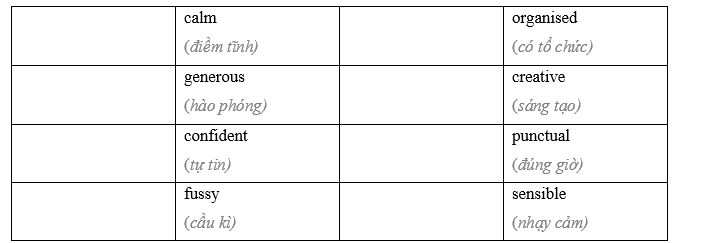Giải SGK, SBT Unit 1. Out of your comfort zone English Discovery
Giải SGK, SBT Unit 1. Out of your comfort zone English Discovery
2 1.01 Put the words in the right column. Which adjectives could go in both columns? Listen and check.
(Đặt các từ vào cột bên phải. Những tính từ nào có thể xếp ở cả hai cột? Nghe và kiểm tra.)
|
Vocabulary A Adjectives of emotion (Từ vựng A) (Tính từ chỉ cảm xúc) |
|
afraid annoyed anxious confused determined disappointed |
Từ vựng:
afraid (a): sợ
annoyed (a): khó chịu
anxious (a): lo lắng
confused (a): bối rối
determined (a): quyết tâm
disappointed (a): thất vọng
joyful (a): hân hoan
miserable (a): khổ sở
relaxed (a): thư giãn
satisfied (a): thỏa mãn
stressed (a): căng thẳng
surprised (a): ngạc nhiên
uneasy (a): khó chịu
3 Read the text. Mark the sentences T (true) or F (false).
(Đọc văn bản. Đánh dấu các câu T (đúng) hoặc F (sai).)
Fitting in
Linh grew up in a small village, surrounded by rice paddies and lush green hills in Việt Nam. Life was simple, but she always dreamed of the bright lights of the big city. When she turned 15, her family decided to move to Hồ Chí Minh City. Moving to the city was overwhelming at first. The traffic was chaotic, and the constant noise made it hard to sleep at night. But Linh was determined to have an adventure. She found her new teachers and friends very friendly. They quickly became her new family. As she explored the city, Linh discovered new foods and cultures. She visited museums and art galleries, and even tried to take up street photography. But the city was also full of challenges, and Linh, like her parents, struggled to adapt to the fast-paced lifestyle, expensive transportation and crowdedness. Despite the ups and downs, Linh never regretted her family’s decision to move to the city. She has found a new sense of independence and freedom, and was excited for all the opportunities in this new environment. Even though she sometimes missed the simplicity of her village life, she knew that this is where her heart belongs.
(Phù hợp trong
Linh lớn lên ở một ngôi làng nhỏ được bao quanh bởi những cánh đồng lúa và những ngọn đồi xanh tươi ở Việt Nam. Cuộc sống tuy đơn giản nhưng cô luôn mơ về ánh đèn rực rỡ của thành phố lớn. Khi cô 15 tuổi, gia đình cô quyết định chuyển vào Thành phố Hồ Chí Minh. Việc chuyển đến thành phố lúc đầu thật khó khăn. Giao thông hỗn loạn và tiếng ồn liên tục khiến cô ấy khó ngủ vào ban đêm. Nhưng Linh vẫn quyết tâm phiêu lưu. Cô thấy giáo viên và bạn bè mới của mình rất thân thiện. Họ nhanh chóng trở thành gia đình mới của cô. Khi khám phá thành phố, Linh khám phá ra những món ăn và nền văn hóa mới. Cô đến thăm các viện bảo tàng và phòng trưng bày nghệ thuật, thậm chí còn thử chụp ảnh đường phố. Nhưng thành phố này cũng đầy rẫy những thách thức, và Linh, giống như cha mẹ cô, phải vật lộn để thích nghi với lối sống hối hả, phương tiện đi lại đắt đỏ và sự đông đúc. Dù thăng trầm nhưng Linh chưa bao giờ hối hận về quyết định lên thành phố của gia đình. Cô đã tìm thấy cảm giác độc lập, tự do mới và rất hào hứng với mọi cơ hội ở môi trường mới này. Mặc dù đôi khi cô nhớ sự đơn giản của cuộc sống làng quê nhưng cô biết rằng đây chính là nơi trái tim cô thuộc về.)
|
1 |
Linh spent her childhood in a small village in Việt Nam. (Linh trải qua tuổi thơ ở một ngôi làng nhỏ ở Việt Nam.) |
|
2 |
Since she was a child, Linh always wanted to go to a big city. (Từ nhỏ, Linh luôn mong muốn được đến thành phố lớn.) |
|
3 |
At the age of 15, Linh relocated to Hồ Chí Minh City. (Năm 15 tuổi, Linh chuyển vào TP.HCM.) |
|
4 |
Linh disliked her new school in the city. (Linh không thích ngôi trường mới của cô ở thành phố.) |
|
5 |
Linh and her parents faced challenges while adapting to the city life. (Linh và bố mẹ cô phải đối mặt với nhiều thách thức trong quá trình thích nghi với cuộc sống ở thành phố.) |
|
6 |
Linh was not happy with her family’s decision to move to the city. (Linh không hài lòng với quyết định chuyển lên thành phố của gia đình.) |
4 Read the text again. Linh had some positive and negative experiences when moving to a new city. Put the following items in the right column.
(Đọc văn bản một lần nữa. Linh đã có những trải nghiệm tích cực và tiêu cực khi chuyển đến thành phố mới. Đặt các mục sau vào cột bên phải.)
|
friends lifestyle transportation museums traffic noise street photography |
Từ vựng:
friends (n): bạn bè
lifestyle (n): cách sống
transportation (n): vận tải
museums (n): viện bảo tàng
traffic (n): giao thông
noise (n): tiếng ồn
street photography (n): chụp ảnh đường phố
2 1.06 Complete the sentences with words from the Vocabulary box. Listen and check.
(Hoàn thành câu với các từ trong hộp Từ vựng. Nghe và kiểm tra.)
|
Vocabulary Personality adjectives |
|
calm confident creative curious fussy generous gentle organised punctual reliable sensible |
Từ vựng:
calm (a): điềm tĩnh
confident (a): tự tin
creative (a): sáng tạo
curious (a): tò mò
fussy (a): kén chọn
generous (a): hào phóng
gentle (a): dịu dàng
organised (a): ngăn nắp
punctual (a): đúng giờ
reliable (a): đáng tin cậy
sensible (a): nhạy cảm
1 Someone who always has new ideas is .
(Người luôn có những ý tưởng mới là )
2 Someone you can trust is .
(Người mà bạn có thể tin tưởng là)
3 Someone who worries about things that aren’t important is .
(Người hay lo lắng về những điều không quan trọng là)
4 Someone who is sure about him- or herself is .
(Một người chắc chắn về bản thân mình là)
5 Someone who wants to learn new things is .
(Người muốn học những điều mới là)
6 Someone who always arrives on time is .
(Người luôn đến đúng giờ là)
New experiences
(Những trải nghiệm mới mẻ)
1. Match the adjectives below with pictures 1-6. There are two extra adjectives.
(Ghép các tính từ bên dưới với hình ảnh 1-6. Có hai tính từ thừa.)
|
afraid |
annoyed |
confused |
joyful |
|
miserable |
relaxed |
stressed |
surprised |

5. Complete what the people are saying with the words below.
(Hoàn thành những gì mọi người đang nói bằng các từ bên dưới.)
|
afraid |
boosted |
change |
determined |
disappointed |
|
get |
have |
made |
stressed |
uneasy |
1. This year has been so boring. I'm _______ to an adventure this summer.
2 Some people _______ a buzz out of walking up mountains, but I’m _______ of heights!
3. Gillian _______ plans for the party weeks ago, so she’ll be really _______ if we don't go.
4. Nick felt _______ when meeting new people, but then losing weight ______ his confidence.
5. I don't like it when I have to _______ my routine. It makes me feel _______.
7. Complete the blog post with the words below.
(Hoàn thành bài đăng trên blog bằng những từ bên dưới.)
|
anxious |
challenged |
congratulate |
determined |
give |
|
make |
miserable |
routine |
satisfied |
take |
My thirty-day vegan challenge
This month I am getting out of my comfort zone! How? I've (1) _______ myself to stop eating any meat or animal products for thirty days. I'm not a vegetarian. In fact, I really like meat, but recently I read about the way many animals are treated and it made me feel really (2) _______. I decided to (3) _______ this board and (4) _______ a vegan diet a go. I'm a bit (5) _______ about just eating vegetables and nuts all the time and I'm worried about getting hungry, but I'm (6) _______ to be successful, so I'm going to (7) _______ myself do this for the whole thirty days!
I've just finished my first day and I had lots of fruit for breakfast, and pasta with tomato sauce for lunch. I've changed my (8) _______ because I usually have only a small lunch. The good news is that I felt (9) _______ all afternoon and not hungry at all. In the evening I had a salad with nuts. A positive first day, I think, so time to (10) _______ myself!
Come back tomorrow to read about day 2!
1. Match the words 1-8 on the left with their meanings a-h on the right.
(Ghép các từ 1-8 ở bên trái với nghĩa của chúng từ a-h ở bên phải.)
|
Words |
Meanings |
|
1. downside |
a. incorrect understanding of something or someone |
|
2. touristy |
b. drawback |
|
3. figure out |
c. a deep understanding of something or someone |
|
4. insight |
d. discover the answer to a question |
|
5. misconception |
e. relating to tourists |
|
6. overwhelmed |
f. the feeling of so much of something |
|
7. chaotic |
g. changing from one state to another |
|
8. transition |
h. a state of disorder |
2. Write the questions from Exercise 1 in the correct column.
(Viết các câu hỏi từ Bài tập 1 vào cột đúng.)
|
Asking for help ____________________________________________? ____________________________________________ ____________________________________________ |
|
Offering help ____________________________________________ ____________________________________________ ____________________________________________ |


























